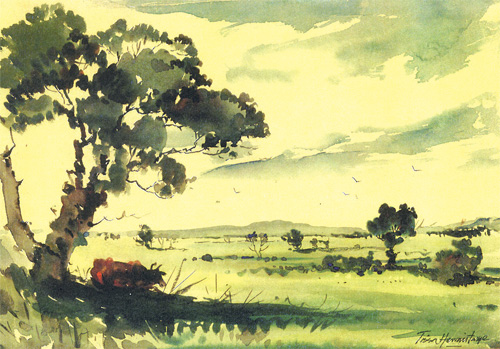Mixing greens in watercolour
by Tissa Hewavitarane
Colour mixing in water-colour can be both fascinating and
frustrating. Sometimes magical things happen, other times a colour will
turn to mud for no apparent reason.
The lush greens of a landscape in high summer are inspiration to any
artist. But the sheer number of different greens to be found in grass
and foliage can be quite overwhelming, for a beginner.
In the painting shown here I have used a more subtle and varied range
of greens in the grass and foliage. Notice how I have introduced
positive contrasts of light and dark greens that enliven the picture and
make the eye to explore the composition.
 |
|
The lush greens of a
landscape |
The sheer number of different shades of green found in the grass and
foliage brings depth to the scene. Not the tree on the left with wide
spread foliage giving a shade to the cow resting and our eye is
automatically drawn to it, thus it forms the focal point of the picture.
Remember when mixing your colours, don't think just "green". Is that a
warm green or a cool green? Study the pattern of warm and cool colour
throughout to composition.
Here the pattern of shadows cast by the tree activates the
composition and creates a buoyant, spring-like feel. Learn how to mix
your own green, using yellows and blues, so that you can vary them from
light to dark, bright to muted and warm to cool.
Observe the tree trunk given a transparent effect adding burnt sienna
and Prussian blue with a light wash.
The cow under the huge tree gives life to the picture. It's always a
huge decision as to whether to put figures or animals you do put in is
an integral part of the picture and not just a small afterthought. They
can be used in different ways to give life, movement and scale to a
scene.
These are of course some splendid greens available in tubes. But
these used alone may not be enough to give you the flexibility required
to capture the subtle nuances that are found in nature's green.
To obtain livelier and more expressive colours, it's often better to
vary your tube greens, by mixing them with blues, reds and orange.
It's amazing how the greens such as Vindian and Windsor green, which
are unnatural in appearance in their pure state, become much more
lifelike when mixed with other colours.
The tiniest drop of Vindian, for instance, when mixed with chrome
yellow produces a luminous transparent green that is ideal for painting
sunlight foliage.
There is always a lot to consider, but the more you account or all
these elements, the more usually satisfying your painting will be. A
sound painting is made up of beautiful arrangements of values and colour. |

